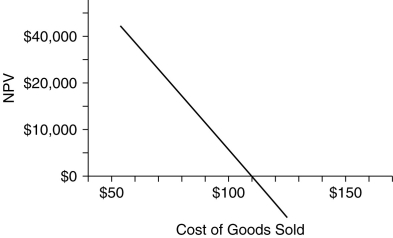Multiple Choice
Use the figure for the question(s) below. 
-A maker of kitchenware is planning on selling a new chef-quality kitchen knife. The manufacturer expects to sell 1.6 million knives at a price of $120 each. These knives cost $80 each to produce. Selling, general, and administrative (SG&A) expenses are $500 000. The machinery required to produce the knives cost $1.4 million, depreciated by straight-line depreciation over five years. The maker determines that the EBIT break-even point for units sold and sale price is less than these estimates and that the EBIT break-even point for costs per unit, SG&A, and depreciation are greater than these estimates, so decides to go ahead with manufacturing the knife. Was this the correct decision?
A) Yes, since a positive EBIT ensures that the project will have a positive net present value (NPV) .
B) No, since the cost per unit should be greater than the EBIT break-even point for cost of goods if the project is to have a positive EBIT.
C) Yes, since if the estimates for each parameter are correct, the EBIT will be positive.
D) It cannot be determined whether the decision was correct, since other factors contributing to the project's net present value (NPV) , such as the upfront investment, have not been included in the analysis.
Correct Answer:

Verified
Correct Answer:
Verified
Q1: After research into where to place a
Q3: Use the table for the question(s)below. <img
Q4: Which of the following costs would you
Q5: A consumer good company is developing a
Q6: Use the information for the question(s)below.<br>The Sisyphean
Q7: What is the ultimate goal of the
Q8: Use the table for the question(s)below. <img
Q9: Use the information for the question(s)below.<br>The Sisyphean
Q10: Use the information for the question(s)below.<br>Shepard Industries
Q11: Which of the following will increase the